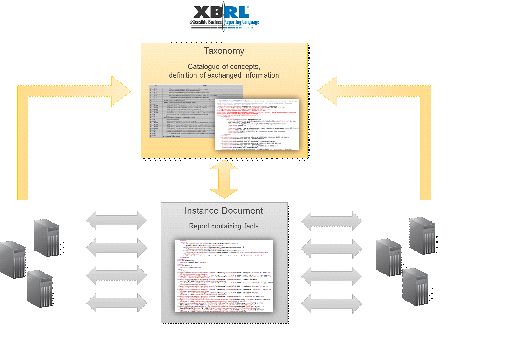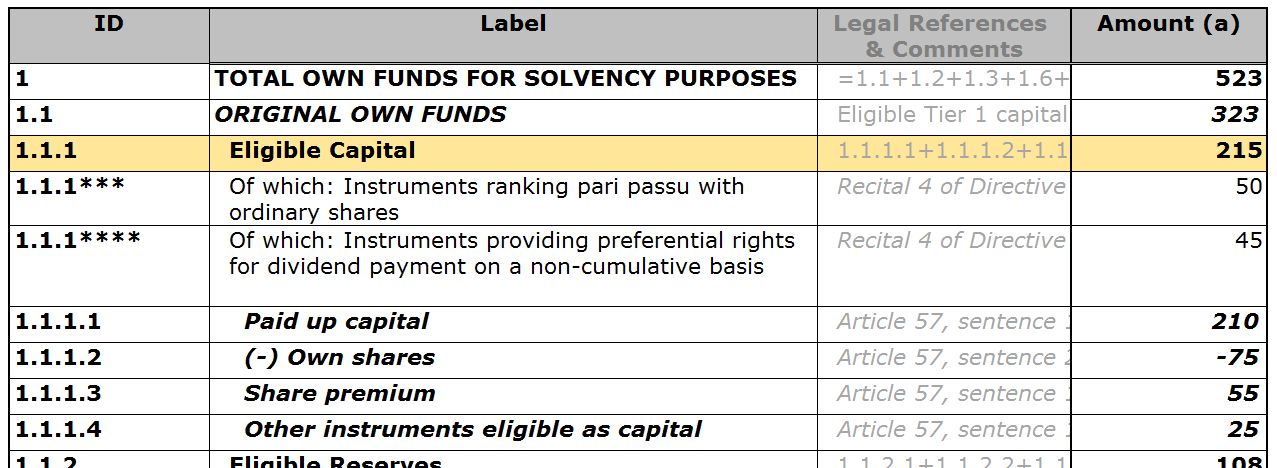European XBRL Reporting Entities handbook
From XBRLWiki
| Revision as of 09:02, 19 November 2012 (edit) Pablo.navarro (Talk | contribs) ← Previous diff |
Revision as of 09:03, 19 November 2012 (edit) Pablo.navarro (Talk | contribs) Next diff → |
||
| Line 95: | Line 95: | ||
| XBRL normalises the '''format''' of data (via the use of XML techniques) en the '''validation''' of data (via XBRL taxonomies).<br /> | XBRL normalises the '''format''' of data (via the use of XML techniques) en the '''validation''' of data (via XBRL taxonomies).<br /> | ||
| - | [[Image: XBRL Language Dagram]]<br /> | + | [[Image:XBRL-LanguageDiagram.jpg]]<br /> |
| <br /> | <br /> | ||
| XBRL also provides among others:<br /> | XBRL also provides among others:<br /> | ||
Revision as of 09:03, 19 November 2012
CEN Workshop Agreement
Status: Working Group Working Draft
Editing rules
Editorial comments should be highlighted as follows: A comment
Text or rules in discussion (white): Some text
Text or rules already aligned (green): Some text
Text or rules to be deleted (red): Some text
Text to be delivered (blue): Some text
Contents |
Foreword
This document is a working document.
This document has been prepared by CEN/WS XBRL, the secretariat of which is held by NEN.
This document is a working document.
Introduction
Scope
The objective of this CWA is to provide a roll-out package for regulators who wish to use XBRL. More precisely, this CWA consists of two parts:
- i) An XBRL supervisory roll-out guide: this is oriented towards national regulators on how to implement, extend and manage XBRL taxonomies
- ii) An XBRL handbook for declarers: this is a roll-out guide or reference handbook would give a general introduction to XBRL and serve as a help to preparers of XBRL (reporting entities)
The scope of the current document is on the second part of the CWA; the XBRL handbook for declarers. In this general guide to XBRL, the following subjects will be addressed: [DRAFT]
Normative references
The following referenced documents are indispensable for the application of this document. For dated references, only the edition cited applies. For undated references, the latest edition of the referenced document (including any amendments) applies.
EN xyz:199x, Title of the european standard.
EN ab c:199x, General title of series of parts — Part c: Title of part.
Terms and definitions
For the purposes of this document, the following terms and definitions apply / the terms and definitions given in … and the following apply.
- Term1
- description on text for term1
- Term2
- description on text for term2
XBRL Introduction
Introduction: from unstructured to structured information
Before starting to explain XBRL, we would like to show via an example why the structuring of reported data can be useful. Reported financial data tend to be represented a table format. For example, the COREP Capital Adequacy table looks this:
Such a representation of information is very human-readable. However, it is not ideal for machine interpretation, as it is not very structured. As a result, the following question comes to mind: How can we structure this information, so that it can be transmitted and interpreted in a consistent way? For the purpose of this example, we’ll focus on the “Eligible Capital” line, which is highlighted in yellow in the above example.
A first step would be to tag the amount of Eligible Capital in a way that it is directly linked to the concept of Eligible Capital:
<p-ca:EligibleCapital>215</p-ca:EligibleCapital>
Although this information is already quite structured, some contextual information is missing. Information like the currency of the amount:
<p-ca:EligibleCapital unitRef=”EUR”>215</p-ca:EligibleCapital>
And finally, the reporting period:
<p-ca:EligibleCapital unitRef=”EUR” contextRef=”2012-12-31”>215</p-ca:EligibleCapital>
The above example shows, in a nutshell, how XBRL allows to structure reporting data.
General Definition of XBRL
XBRL, or eXtensible Business Reporting Language, is a communication standard developed in order to simplify the exchange of business and financial data.
XBRL normalises the format of data (via the use of XML techniques) en the validation of data (via XBRL taxonomies).

XBRL also provides among others:
- Standard validation rules (mathematical and logical rules)
- The use of label linkbases (which allows multi-lingual taxonomies)
- The possibility to provide rendering
- Standard toolset which allow to work with XBRL
XBRL Components
XML
XML, or eXtensible Markup Language, is a W3C standard which allows to represent structured data in the form of flat text. This representation is both machine readable as human readable.
Simple XML example:
<?xml version="1.0" encoding="utf-8"?> <playlist name="mylist" xml:lang="en"> <song> <title>Yesterday</title> <artist>The Beatles</artist> </song> <song> <title>Mother's Little Helper</title> <artist>The Rolling Stones</artist> </song> </playlist>
XML languages use elements & attributes in order to structure content. The XML specification defines the syntax of elements, attributes en other structures which can appear in XML documents.
XML Schema (XSD) is a language used for describing the structure of XML documents. XML Schema allows the creation of schema's of for example XML-documents, by which these documents are formally specified and by which they can be validated by XML validators. An XML Schema provides among others what the elements of an XML document are, where they appear, what characteristics must be respected, etc…
An XML document can be correct (well-formed) according to the general XML standard, but also invalid according towards a specific XML Schema.
[Further explain XML and components like: XML namespaces, XML schema, XPath, XLink, XPointer]
XBRL Taxonomy
[Chapter explains the main purpose of XBRL taxonomy (definition of reporting concepts)]
An XBRL Taxonomy is a collection of taxonomy schemas and linkbases. A taxonomy schema is an XML schema document (file). Linkbases are XML documents (file) which follow the XLink specification. The schema must ultimately extend the XBRL instance schema document and typically extend other published XBRL schemas on the xbrl.org website.
Taxonomy schemas define Item and Tuple "concepts" using <xsd:element> elements. Concepts provide names for the fact and indicate whether or not it's a tuple or an item, the data type (such as monetary, numeric, fractional, or textual), and potentially more metadata. Items and Tuples can be regarded as "implementations" of concepts, or specific instances of a concept. A good analogy for those familiar with object oriented programming would be that Concepts are the classes and Items and Tuples are Object instances of those classes. This is the source of the use of the "XBRL instance" terminology. In addition to defining concepts, taxonomy schemas reference linkbase documents. Tuples instances are 1..n relationships with their parents; their metadata is simply the collection of their attributes.
Linkbases are a collection of Links, which themselves are a collection of locators, arcs, and potentially resources. Locators are elements that essentially reference a concept and provide an arbitrary label for it. In turn, arcs are elements indicating that a concept links to another concept by referencing the labels defined by the locators. Some arcs link concepts to other concepts. Other arcs link concepts to resources, the most common of which are human-readable labels for the concepts. The XBRL 2.1 specification defines five different kinds of linkbases:
- Label Linkbase
- Reference Linkbase
- Calculation Linkbase
- Definition Linkbase
- Presentation Linkbase
[TODO: add more details on the linkbases]
XBRL Instance Document
The XBRL instance begins with the <xbrl> root element. There may be more than one XBRL instance embedded in a larger XML document. The XBRL instance itself holds the following information:
- Business Facts: facts can be divided into two categories
- Items are facts holding a single value. They are represented by a single XML element with the value as its content.
- Tuples are facts holding multiple values. They are represented by a single XML element containing nested Items or Tuples.
In the design of XBRL, all Item facts must be assigned a context.
- Contexts define the entity (e.g. company or individual) to which the fact applies, the period of time the fact is relevant, and an optional scenario. Date and time information appearing in the period element must conform to ISO 8601. Scenarios provide further contextual information about the facts, such as whether the business values reported are actual, projected, or budgeted.
- Units define the units used by numeric or fractional facts within the document, such as USD, shares. XBRL allows more complex units to be defined if necessary. Facts of a monetary nature must use a unit from the ISO 4217 namespace.
- Footnotes use XLink to associate one or more facts with some content.
- References to XBRL taxonomies, typically through schema references. It is also possible to link directly to a linkbase.
SHOW (via a practical example) how an instance document is constructed: namespaces, contexts & units, facts, …
XBRL Recommendations
XBRL 2.1 Standard
XYZ
XBRL Dimensions 1.0 Specification
The Dimensions 1.0 Specification is a modular, optional extension to the XBRL 2.1 Specification which allows XBRL taxonomy authors to define and restrict dimensional information for instance authors to use in the segment and scenario elements of the context element of XBRL instance documents. Its architecture is such that any XBRL artefacts (instances and their Discoverable Taxonomy Sets) that conform to this specification also conform to the XBRL 2.1 Specification and may be processed without error by any processor that is capable of correctly processing XBRL artefacts, even if those processors are unaware of this modular extension.
XBRL Formulas 1.0 Specification
A XBRL formula specifies validations based on XBRL instance facts and generation of derived data as output XBRL instance facts.
The goals of XBRL formula are to provide validation capabilities not available in the Base Specification (XBRL 2.1) validation, dimensional validation, in a manner that is closely attuned to XBRL semantics, intuitive in XBRL terms, suitable for business users, extensible, and maintainable. XBRL formula is designed to accommodate the significant variation between filers, annually-released authority instances and filing rules. Finally it is designed to be formally documenting, both for its own maintenance, and to support audit functions.
A goal of XBRL formula is that output instance documents can represent many kinds of derived data, such as transformations, determination of ratios, and data mining.
Transformations can include transforming from one kind of taxonomy to another (for example from Global Ledger to a Financial Reporting taxonomy), from one version of a the same taxonomy to another (such as where namespaces change and some concepts are mapped), and in mapping between different accounting schedules of the same taxonomy (such as relating cash flow to balance sheet and transactions).
Determining of ratios and data mining can identify derived financial data, such as common ratios. In the case of XBRL filings for SEC and IFRS, individual filers may have financial reports that use different concepts or accounting rules than each other. In this case a goal of XBRL formula is to be able to provide declarative specifications that aid in identifying such concepts, which may be by knowing names of alternative names of concepts or possibly by knowing the relationship of concepts to each other (in XBRL's linkbases).
Bibliography
- [1] :xxx
- [2] :xxx


